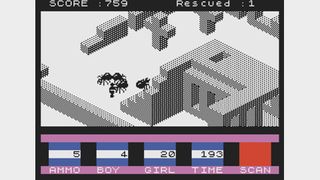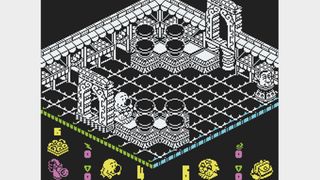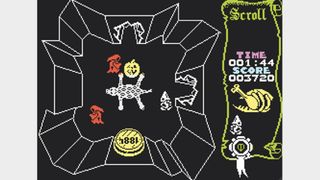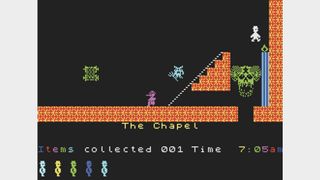10 Best Spectrum games of all-time
Retro Gamer picks the best ZX Spectrum games ever

The 8-bit Spectrum had a host of fantastic games available for it, covering a wide range of genres. Here are the 10 best Spectrum games that every serious Spectrum owner should have in their collection.
Starquake

Released: 1985
Steve’s Crow unbelievably addictive flick-screen platformer mixes pure playability with crisp sci-fi graphics and frantic puzzle solving. It’s one of those games where every aspect has been polished to gleaming perfection; whether it’s the mini-Mastercards that open any doors (geddit), the ability to summon temporary platforms beneath you at will, or the handy passworded teleporters that make light work of navigating the immense caverns. But it’s the sheer speed of the thing that makes Starquake such an exhilarating experience on the Spectrum. Crow’s devious mazes require serious cunning to traverse, and it’s all kept at a feverish pace thanks to a constant supply of energy-sapping enemies. A must for every Spectrum aficionado, Starquake is pure 48k bliss.
Ant Attack

Released: 1983
Few games in the early Eighties were as atmospheric and downright terrifying as Ant Attack, the first real home video game to be viewed from an isometric perspective. The ghostly monotone graphics only served to intensify the desolation of the abandoned walled city of Antescher, and made the sudden appearance of the titular arthropods even more shocking. Typical games are spent tear-arsing around the tomb-like structures desperately following the green or red signals from your scanner to locate each lost soul. Sudden ant attacks are agile and persistent and require a dash to high ground or a well-aimed grenade to avoid. One of the few games to actually allow you to choose your sex, Ant Attack is still a prime example of a simple concept well implemented and burnt into the minds of a generation of gamers.
Head Over Heels

Released: 1987
Pre 1987 Ritman and Drummond had toyed with the likes of the similarly isometric Batman. But it was with Head Over Heels that the duo truly achieved greatness. It’s difficult to describe now the impact this game had when it was released; surpassing every other 3-D platformer in an instant with its relentless assault of clever ideas, kitsch graphics and surefooted game design. Ritman is a master of Rubik’s Cube-style puzzles and nearly every room requires lateral thinking and more than a dash of fingertip dexterity. Dividing the Head and Heels character’s abilities, so that they can only progress so far as separate entities and must literally join forces to complete the game, is a masterstroke, and typical of the ingenuity that seeps from the game’s every pore.
Sign up to the GamesRadar+ Newsletter
Weekly digests, tales from the communities you love, and more
The Great Escape

Released: 1986
In the year of the space shuttle Challenger disaster, Spectrum owners were treated to one of the finest isometric adventures ever to appear on Sir Clive’s rubber marvel. The Great Escape is set in a Colditz-style POW camp during WWII, and the objective is to escape before your morale is crushed, and without alerting the guards and getting thrown into the cooler. What makes the game so compelling is the attention to detail and a real sense of confinement. The graphics are finely crafted, and clever little touches like the morale flag, the searchlights at night, the hidden tunnels, and the way you default to the camp routine if you stop playing, make the game a true classic. Just look at it.
Atic Atac

Released: 1983
No ‘perfect ten’ list for the Spectrum would be complete without a solid showing from the Stamper brothers and their superb Ultimate label. Atic Atac makes it into the list by a narrow margin (so many Ultimate games are outright classics) because it set the scene for Ultimate to dominate the Spectrum. Playing as Knight, Wizard or Serf, Atic Atac is an overhead perspective arcade adventure set over 200+ rooms in a gothic castle populated by endless minions, as well as Frankenstein, Quasimodo, the Mummy and of course Dracula. It’s fast, it’s challenging, and even today it provides hours of entertainment.
Quazatron

Released: 1986
We’re going out on a bit of a limb here, because Steve Turner’s Quazatron is not generally considered one of the top ten Spectrum games, but hey, it’s our list, right? So what if it stole C64 Paradroid’s innovative ‘grappling’ system, and the lifts to other levels are kinda similar, Quazatron carves a niche for itself, and you can’t deny the clever use of colour, the detail on the droids, and the Marble Madness-inspired gameplay. Where Quazatron scores highly is the player’s desire to battle and strip the best parts from your fellow robots, boost their own abilities, and then wipe each level clean before descending to the next. A simply magnificent game.
Back To Skool

Released: 1985
Together with the original Skool Daze, Skool represents bedroom programming at its best – quintessentially British, packed with detail, and eminently playable, how could this game fail to appeal to its audience of rowdy teenagers? Allowing the player to individually name the cast of characters was Reedy’s masterstroke because it meant your could personalise and relate to them instantly. What makes Back to Skool such a great Spectrum game though is the way it plays and the St Trinians-esque details, like riding the bike through the school, shooting water pistols, releasing the mouse to make the girls jump, and of course avoiding the cane of the sinister Mr Whacker. Fond, fond memories…
Jet Set Willy

Released: 1984
The follow-up to Manic Miner is set in a sprawling mansion (bought with the profits from mining no doubt) and is both exciting and infuriating in equal measures. Gaming legend Matthew Smith showers you with extra lives to help you collect the 83 flashing objects – and you need them, as the difficulty level in rooms like the Banyan Tree, Out on a Limb, and the Forgotten Abbey is utterly insane! Smith’s Python-inspired characters and unforgiving gameplay has sealed JSW’s place in Spectrum history and spawned a hundreds clones, the best of which is probably Elite’s Rollercoaster.
Rebel Star

Released: 1986
Just pipping Gollop’s earlier masterpiece, Chaos, into our top ten, Rebel Star is a turn-based sci-fi strategy game in which you control either of two opposing forces in a moonbase battle (there was also a two player game on the flip-side of the tape and all for £1.99!). What seals Rebel Star’s greatness is the pure strategy and cunning that must be employed to succeed; making the best of your forces’ abilities and different armaments. Julian Gollop, where are you now?
Elite

Released: 1985
No top ten could be complete without the obligatory conversion of the ultimate space trading game, and this Torus version remains faithful to Bell and Braben’s original vision whilst at the same time adding some enhancements. That’s if you could actually play the damn thing however, because Elite was the first ever game to utilise the Lenslock anti-piracy thingy, which managed to frustrate legitimate customers and pirates in almost equal measures. Fortunately Elite was worth it, with ultra-smooth and flicker-free frame rate, impressive magenta explosions, and for the 128k at least, three special missions.
Retro Gamer is the world's biggest - and longest-running - magazine dedicated to classic games, from ZX Spectrum, to NES and PlayStation. Relaunched in 2005, Retro Gamer has become respected within the industry as the authoritative word on classic gaming, thanks to its passionate and knowledgeable writers, with in-depth interviews of numerous acclaimed veterans, including Shigeru Miyamoto, Yu Suzuki, Peter Molyneux and Trip Hawkins.
Most Popular




